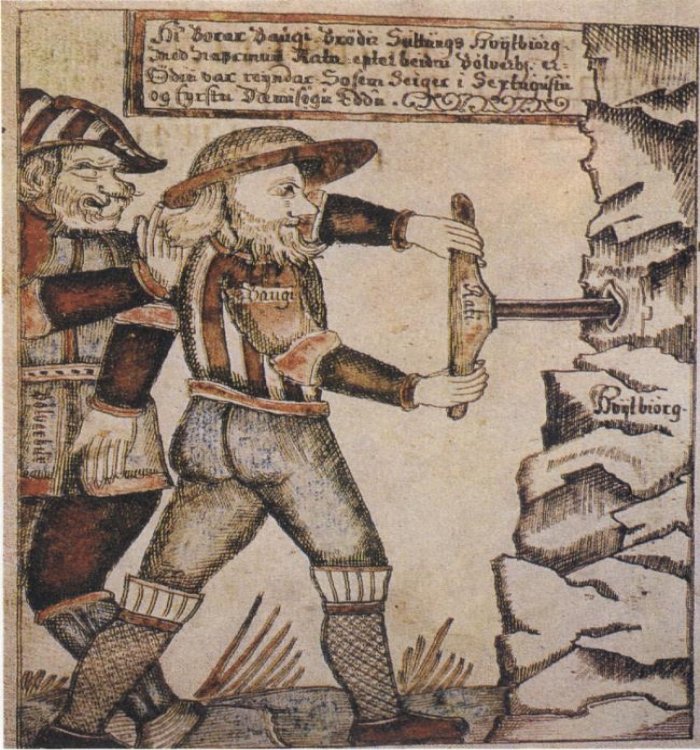Mead Of Poetry: Odin Gave This Magical Potion To Gods, Valkyries And Humans
A. Sutherland - AncientPages.com - Odin is a god of war, death, poetry, and wisdom in Norse mythology. He often spoke in beautiful poems.
But before he became the god of poetry, he had to steal and consume the Mead of Poetry; a magical potion even called "the stirrer of inspiration," was a source of unlimited knowledge, inspiration, and eloquence.
A giant Suttung and his daughter protected the magical and priceless drink. Odin had to call on all his powers of deception and cunning to steal it.
At the top of the drawing is written: "Here drills Baugi, Suttung brother, Hnitberg with drill Rati following command from the Bolverk, which by the way was Odin, as it is told in the sixty-first example of Edda.
As we know, Odin was always seeking wisdom, even at a high personal cost. He was already a great master of supernatural powers, but he wanted to go to a further extreme to master even more.
Eventually, he became known as the God of Poetry, speaking in beautiful poems and gladly giving poetic talent to gods, humans, and others he considered worthy of this supernatural gift.
But before that happened, Odin had to figure out how to access the mountain, which was giant Suttung's home.
Disguised as a mortal and calling himself, Bolverk ('Evil-Doer'), Odin set forth to obtain the mead.
He took up lodgings with Suttung's brother, a giant Baugi, the owner of nine slaves. Odin murdered them and offered to do their work for a price of one drink of Suttung's mead of poetry.
When winter came, Odin/Bolverk completed his work and came to Baugi demanding his reward. Baugi was not authorized to accept such a request, but he agreed. Both men set off for Suttung's mountain dwelling.
When they arrived, giant Suttung refused to participate in Bolverk and Baugi's agreement.
Then, Bolverk decided to use en auger (an instrument for boring) and ordered Baugi to bore a hole in Hnitberg (Hnitbjörg) mountain, which he believed contained the mead.
Soon, a tunnel was created, and Bolverk could transform into a snake and crawl into an inner chamber, where he changed his appearance again into a young, beautiful man to meet Suttung's daughter, Gunnlöd (whose name means "invitation to the battle").
She guarded the precious liquid, so Odin had to spend three nights with her, and after this time together, Gunnlöd, who fell in love with him. Thus, he could have three draughts of mead.
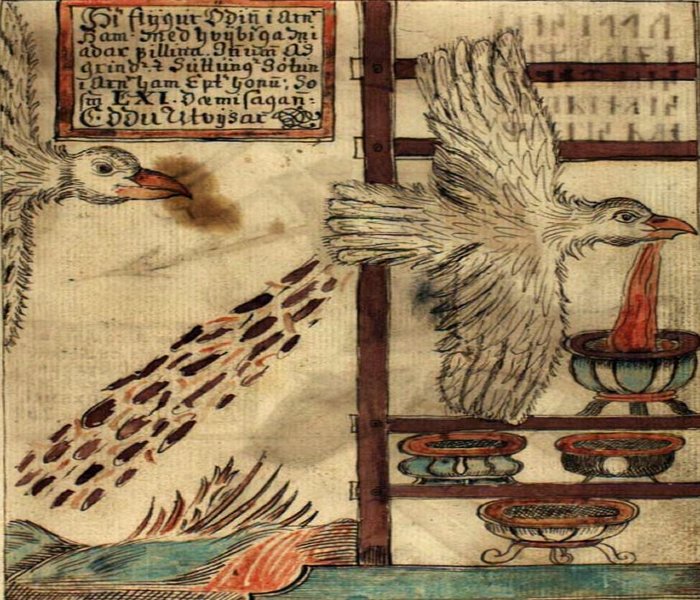
An Icelandic 17th century drawing depicting Odin taking mead to Valhalla. Eddahandskrift. Ny kgl. Saml. 1867 4, Det Kongelige Bibliotek, Köpenhamn
But each emptied a container. Then, Odin turned himself into an eagle and flew to Asgard, the kingdom of the Norse gods.
When the Aesir gods saw Odin flying towards them, they were ready to help him by placing special containers in the courtyard. Thus, Odin, who flew overhead, could release the mead into them, and so he did.
He also gave the mead to the Valkyries for reviving dead heroes upon their arrival in Valhalla and all mortals on earth.
Did Odin really want to give mortals some of the magical potion?
In another version of this beautiful myth, we learn that furious Suttung, also transformed into an eagle following Odin in pursuit. Being very close behind, Suttung caused Odin to spill some of the magical drink outside the walls of Asgard, and since that time, any mortal can benefit from it - if he/she so wishes.
Updated on January 21, 2022
Written by – A. Sutherland AncientPages.com Staff Writer
Copyright © AncientPages.com All rights reserved. This material may not be published, broadcast, rewritten or redistributed in whole or part without the express written permission of AncientPages.com
Expand for referencesReferences:
Lindow, Norse Mythology
More From Ancient Pages
-
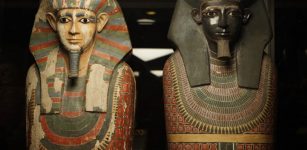 Egyptian Tomb Of The Two Brothers – DNA Solves Ancient Egyptian Mystery
Archaeology | Jan 17, 2018
Egyptian Tomb Of The Two Brothers – DNA Solves Ancient Egyptian Mystery
Archaeology | Jan 17, 2018 -
 Unknown Ancient Settlement Overlapping The Old City Of Nakhon Ratchasima Discovered
Archaeology | Mar 14, 2025
Unknown Ancient Settlement Overlapping The Old City Of Nakhon Ratchasima Discovered
Archaeology | Mar 14, 2025 -
 Pompey The Great: One Of Roman Empire’s Most Successful Military Commanders
Featured Stories | Jun 14, 2019
Pompey The Great: One Of Roman Empire’s Most Successful Military Commanders
Featured Stories | Jun 14, 2019 -
 Medicine in Antiquity: From Ancient Temples To Roman Logistics
Archaeology | Apr 13, 2018
Medicine in Antiquity: From Ancient Temples To Roman Logistics
Archaeology | Apr 13, 2018 -
 Animal Tracks And Human Footprints In Prehistoric Hunter-Gatherer Rock Art In Namibia
Archaeology | Sep 13, 2023
Animal Tracks And Human Footprints In Prehistoric Hunter-Gatherer Rock Art In Namibia
Archaeology | Sep 13, 2023 -
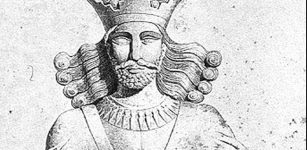 Darabgerd: One Of The Oldest Cities Dated To Achaemenid Era
Featured Stories | Jan 28, 2021
Darabgerd: One Of The Oldest Cities Dated To Achaemenid Era
Featured Stories | Jan 28, 2021 -
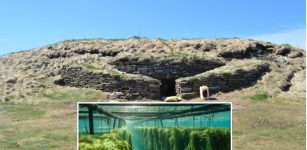 Ancient Europeans Ate Seaweed And Freshwater Plants – Evidence Found
Archaeology | Oct 17, 2023
Ancient Europeans Ate Seaweed And Freshwater Plants – Evidence Found
Archaeology | Oct 17, 2023 -
 Ji Gong: Legendary Ancient Monk Who Defended People Against Injustice
Chinese Mythology | Jan 31, 2016
Ji Gong: Legendary Ancient Monk Who Defended People Against Injustice
Chinese Mythology | Jan 31, 2016 -
 Surprising Evolution Discovery – Extinct Subterranean Human Species With Tiny Brains Used Fire
Archaeology | Dec 9, 2022
Surprising Evolution Discovery – Extinct Subterranean Human Species With Tiny Brains Used Fire
Archaeology | Dec 9, 2022 -
 A New William Shakespeare First Folio discovered on Isle of Bute, Scotland
Archaeology | Apr 10, 2016
A New William Shakespeare First Folio discovered on Isle of Bute, Scotland
Archaeology | Apr 10, 2016 -
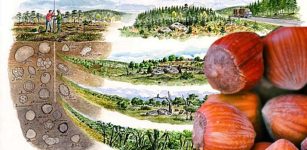 Hazelnuts -‘Time Capsule’ To Reconstruct Landscape Of Ancient Forests In Sweden
Archaeology | Mar 5, 2024
Hazelnuts -‘Time Capsule’ To Reconstruct Landscape Of Ancient Forests In Sweden
Archaeology | Mar 5, 2024 -
 People Of India In Focus: Where Did They Come From?
Civilizations | May 11, 2017
People Of India In Focus: Where Did They Come From?
Civilizations | May 11, 2017 -
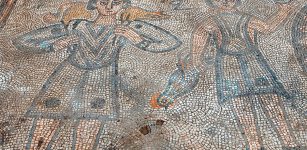 Mosaics Discovered In 1,600-Year-Old Church In Mardin Province,Turkey
Archaeology | Sep 22, 2020
Mosaics Discovered In 1,600-Year-Old Church In Mardin Province,Turkey
Archaeology | Sep 22, 2020 -
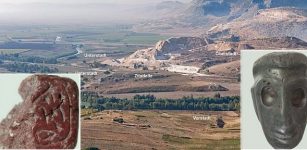 Bronze Age And Iron Age City Complex Once Known As Kummanni Unearthed In Turkey
Archaeology | Dec 4, 2018
Bronze Age And Iron Age City Complex Once Known As Kummanni Unearthed In Turkey
Archaeology | Dec 4, 2018 -
 Rhetorica ad Herennium: Ancient Book That Improves Your Memory Using Method Of Loci – You Can Test It Easily
Featured Stories | Feb 21, 2025
Rhetorica ad Herennium: Ancient Book That Improves Your Memory Using Method Of Loci – You Can Test It Easily
Featured Stories | Feb 21, 2025 -
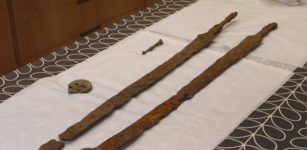 Unique Ancient Roman Cavalry Swords Found In Cotswolds, UK
Archaeology | Sep 18, 2023
Unique Ancient Roman Cavalry Swords Found In Cotswolds, UK
Archaeology | Sep 18, 2023 -
 Unsolved Mystery Of Gedi Ruins Protected By The ‘Old Ones’ – Why Did People Leave?
Civilizations | Apr 2, 2019
Unsolved Mystery Of Gedi Ruins Protected By The ‘Old Ones’ – Why Did People Leave?
Civilizations | Apr 2, 2019 -
 Controversial Artifact: What Kind Of Message Does The Phaistos Disk Contain?
Artifacts | May 13, 2014
Controversial Artifact: What Kind Of Message Does The Phaistos Disk Contain?
Artifacts | May 13, 2014 -
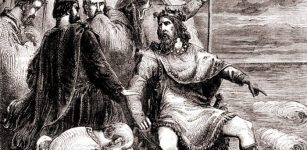 On This Day In History: Canute – Cnut The Great – Danish King Of England Died – On Nov 12, 1035
Featured Stories | Nov 12, 2016
On This Day In History: Canute – Cnut The Great – Danish King Of England Died – On Nov 12, 1035
Featured Stories | Nov 12, 2016 -
 100,000-Year-Old Case Of Deafness Discovered In Fossilized Skull Of Hunter-Gatherer
Archaeology | Jul 21, 2022
100,000-Year-Old Case Of Deafness Discovered In Fossilized Skull Of Hunter-Gatherer
Archaeology | Jul 21, 2022

